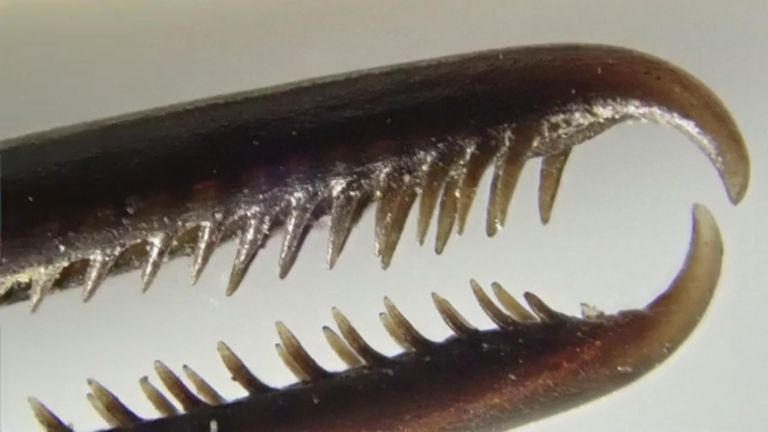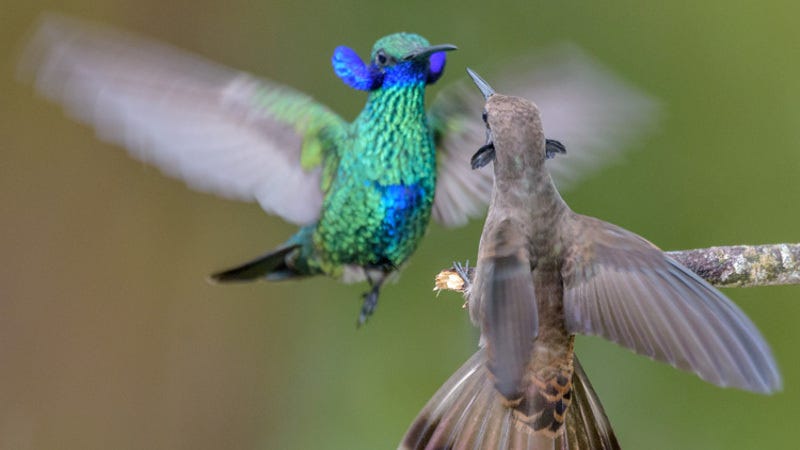Extraordinary in Flight, Exquisite to Behold
"[Hummingbirds offer] opportunities to explore the limits of physiology [as creatures with the highest metabolic rate among vertebrates and their hovering specialization] the most expensive form of locomotion [in terms of energy expenditure] in nature."
"Everybody wants to replicate hummingbird flight [in the design of flying robots]."
"What has kept me attached to them is their incredible personality. They are very bold."
"We understand hummingbirds' lives as being all about drinking efficiently from flowers, but then suddenly we see these weird morphologies - stiff bills, hooks and serrations like teeth - that don't make any sense in terms of nectar collection efficiency."
"Looking at these bizarre bill tips, you would never expect that they're from a hummingbird or that they would be useful to squeeze the tongue."
"Extracting nectar is what fuels their lives [as a result, they have developed] very flexible bills with very soft edges, soft, blunt bill tips that are concave, like a couple of spoons, that perfectly match the tongue to squeeze out the last drop of nectar. All of these traits make a good seal between the tongue tips that actually enhances the efficiency of nectar extraction."
Dr. Alejandro Rico-Guevara, researcher, University of California, Berkeley
 |
| A male long-billed hermit (Phaethornis longirostris) shows off his pointy beak, which he uses as a weapon during territorial disputes. (Photo by Maxime Aliaga) |
Dr. Rico-Guevara studied birds under an academic supervisor -- his specialty as a budding ornithologist -- at the National University of Colombia. Under the supervision given him there he wrote an honors thesis on how hummingbirds hunt insects in supplementing their diet of pure sugar [nectar from flowers]. Finally, Dr. Rico-Guevara did his Ph.D. research with Margaret A. Rubega, biologist at the University of Connecticut.
Dr. Rubega had published a paper observing how hummingbirds bend their bills to capture insects. And when Dr. Rico-Guevara studied under Dr. Rubega he co-produced research findings with his supervisor on hummingbird tongues which entirely turned around the conventional thinking of how hummingbirds suck nectar up from tube-shaped flowers. It was assumed that the shape of the beak and the tongue worked to produce capillary action where liquid rises against gravity in response to mechanical forces.
However, the research undertaken by Drs. Rubega and Rico-Guevara demonstrated that the feeding method hummingbirds used was not at all as imagined, for as the forked tip of its tongue is withdrawn upward within the narrow bill, it traps nectar. And now, newer research findings by Dr. Rico Guevara and other researchers is highlighting the reality that those lovable, exquisitely fragile and outstandingly beautiful tiny birds are in fact, aggressive warriors.
 |
| The teeth are designed to tug away rivals. Pic: UC, Berkeley |
They produced a paper recently where they outlined evidence gathered through high-speed video demonstrating how the deadly beaks of those minuscule birds become weapons in male-to-male hummingbird conflict where rival battles are fought in competition for female hummingbirds as mates. This demonstrates a part of natural selection -- sexual selection -- where the dominant force becomes the improvement of mating opportunities, and where the males use their bills to stab other males, to fence -- feinting, parrying, knocking another bird off its perch.
Some hummingbirds come equipped with hooked beaks and with serrations lining those beaks similar to teeth of a crocodile which are used to tear feathers, as with grippers. But fighting between hummingbirds is not strictly monopolized by males alone; females fight as well, but weaponized bills are restricted to only a few species.
"Males fight in claiming the most superior territories for mating. Their territories are about 25 square meters; the size in keeping with that of the birds exploiting a given territory and its food source for their survival.
"As a hummingbird inserts its bill into a flower, it still needs to stick its long tongue deeper inside to get at the nectar within. After the tongue fills with nectar, the bird retracts the tongue back inside the bill. Researchers already knew that to keep the nectar inside the beak, the hummingbird squeezes the tongue with the bill tips as it is extended for the next lick. That compresses and flattens the tongue on its way out, leaving the nectar inside the bill. The way in which the nectar is moved from the bill tip to where it can be swallowed remains unknown."
Dr. Alejandro Rico-Guevara
When a hummingbird
inserts its bill into a flower, it still needs to stick its long tongue
deeper inside to get at the nectar within. After the tongue fills with
nectar, the bird retracts the tongue back inside the bill. Researchers already knew
that to keep the nectar inside the beak, the hummingbird squeezes the
tongue with the bill tips as it is extended for the next lick. That
compresses and flattens the tongue on its way out, leaving the nectar
inside the bill. The way in which the nectar is moved from the bill tip
to where it can be swallowed remains unknown.
Read more at: https://phys.org/news/2015-08-hummingbird-tongues-tiny-nectar.html#jCp
Read more at: https://phys.org/news/2015-08-hummingbird-tongues-tiny-nectar.html#jCp
 |
Labels: Bioscience, Hummingbirds, Research

0 Comments:
Post a Comment
<< Home